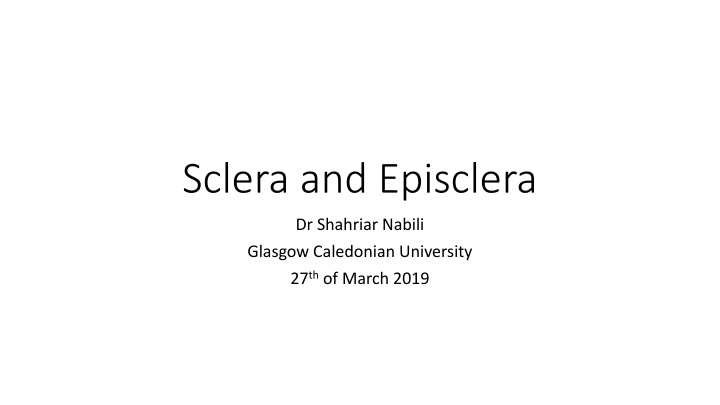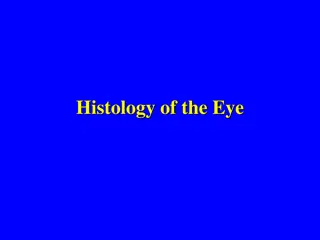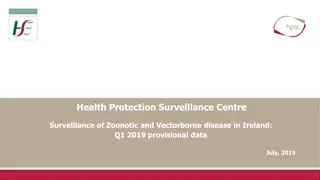
Understanding Sclera and Episclera: Functions, Diseases, and Symptoms
Explore the roles of sclera and episclera in eye health, the differences between scleritis and episcleritis, associated diseases, symptoms like pain and ocular tenderness in scleritis, and the importance of timely evaluation and treatment. Learn about the structure and characteristics of the sclera, along with the risks posed by various diseases affecting these eye structures.
Download Presentation

Please find below an Image/Link to download the presentation.
The content on the website is provided AS IS for your information and personal use only. It may not be sold, licensed, or shared on other websites without obtaining consent from the author. If you encounter any issues during the download, it is possible that the publisher has removed the file from their server.
You are allowed to download the files provided on this website for personal or commercial use, subject to the condition that they are used lawfully. All files are the property of their respective owners.
The content on the website is provided AS IS for your information and personal use only. It may not be sold, licensed, or shared on other websites without obtaining consent from the author.
E N D
Presentation Transcript
Sclera and Episclera Dr Shahriar Nabili Glasgow Caledonian University 27thof March 2019
Sclera Outer tough shell of the eye Protects the delicate structures inside Anteriorly it becomes cornea (limbus) Posteriorly it form optic nerve dural sheath It serves as a conduit for blood vessels and nerves It provides attachment points for extra-ocular muscles Weakly attached to underlying Choroid Outermost layer is called Episclera Heals poorly due to poor blood supply
Sclera Thickness ranges from 0.3 mm to 1.00mm Thickest at optic nerve and thinnest behind the insertion of muscles Sclera is white but can look blue in children because it is transparent Can also look yellow in jaundiced patient
Diseases of Sclera Episclera Scleritis versus Episcleritis Scleritis is rare (0.08%), Episcleritis is not rare Anterior scleritis versus posterior scleritis Inflammation (local or manifestation of systemic disease) Systemic diseases such as Rheumatoid arthritis or Systemic Lupus Erythematosus. 57% of patient have a disease association More common in women and more prevalent in 4th-6thdecade of life Trauma
Scleritis Pain, tearing or photophobia, ocular tenderness, and decreased visual acuity. Pain is the most common symptom for which patients seek medical assistance, and it is the best indicator of active inflammation. Pain results from both direct stimulation and stretching of the nerve endings by the inflammation. Severe, penetrating pain that radiates to the forehead, brow, jaw, or sinuses Awakens the patient during the night Exacerbated by touch; extremely tender Only temporarily relieved by analgesics Often misdiagnosed with conjunctivitis
Scleritis This discoloration does not blanche after topical applications of routine sympathomimetic dilating agents (Phenylephrine 10% eye drops) Need to perform a full eye examination and refer for systemic work up It can cause severe keratitis, glaucoma, uveitis and cataract Ultrasound or CT useful in posterior sclertitis
Anterior Scleritis Diffuse, nodular, necrotizing (either with perforation or non perforating) Red and painful eyes and vision can also be affected
Scleritis-Prognosis and Treatment Prognosis depends on the underlying disease Chronic versus episodic Treatment usually requires oral immunosuppression combined with aggressive topical steroids Oral Non-steroidal anti-inflammatory drugs can also be useful (Ibuprofen) Surgery for perforation (very rare) Usually needs review by Rheumatologists as well
Episcleritis Usually a mild, self-limiting, recurrent disease Most cases are idiopathic, although up to one third have an underlying systemic condition (Rheumatoid arthritis and connective tissue disorders). Foreign bodies can also cause episcleritis Diffuse versus nodular Nodular more prolonged and painful than diffuse Diffuse episcleritis (84% of cases) is more common than nodular scleritis (16% of cases), and the mean age of all patients with episcleritis is 47.4 years
Episcleritis Prognosis is good Self limiting disease The injection in episcleritis blanches with instillation of 10% phenylephrine ophthalmic drops, but not in scleritis Episcleritis can cause uveitis and raised IOP Diagnosis is clinical. Good history taking is essential Full eye examination Sometime requires blood tests if systemic association is suspected
Episcleritis treatment Nothing Lubrication Topical Steroid Topical NSAID (Acular) Systemic Steroid (rarely)
Take home message Keratitis, conjunctivitis, episcleritis, scleritis Blur vision? Pain? Watery eye? Sticky? Exudattion Slit lamp features Fundoscopy History Systemic inquiry






















